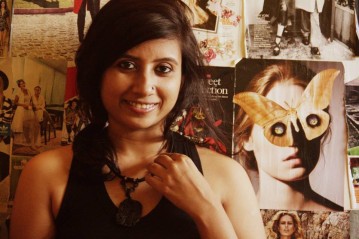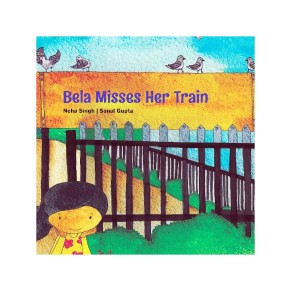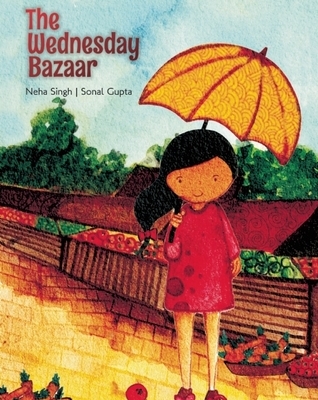By Neha Singh
 When I was growing up in the eighties, I read a lot. Enid Blytons, Nancy Drews, Russian folktales, Grimms’ fairytales, Hardy boys, Agatha Christies, Tintin, Asterix comics etc. etc. There was one thing in common in all these books and comics, none of them were Indian.
When I was growing up in the eighties, I read a lot. Enid Blytons, Nancy Drews, Russian folktales, Grimms’ fairytales, Hardy boys, Agatha Christies, Tintin, Asterix comics etc. etc. There was one thing in common in all these books and comics, none of them were Indian.
I grew up reading about characters, places and events that were completely alien to my own life and context. But this was very normal, since everyone around me was also reading stories about ‘Jane’ and ‘Timothy’ and ‘Alice’ who ate marmalade on toast and lived in ‘barns’ and ‘attics’.
I am very happy to see so many Indian books for children in bookstores these days. Indian publishers, publishing Indian stories about Indian people written by Indian writers. It is very heartening to see stories about ‘rotis’ and ‘farmers’ and ‘cows’ and ‘kites’ and ‘bananas’ and ‘saris’ which are so Indian and I am sure when children read these books they immediately feel connected to these stories. Things definitely seem to be moving in the right direction.
However, something still needs a dramatic change. The misrepresentation and underrepresentation of girls in books for children. Much harm has already been done by years and years of content about princesses, fairies and damsel in distresses. Not to mention the skewed depiction of women characters in our Indian mythology, which is the most dominant literature for Indian children, even today. Sacrificial, virginal characters like Sita, Yashoda, Gandhari, Kunti, Devki etc. or ‘witch-like’ characters like Surpanakha, Hidamba, Putana are black or white portrayals between the devoted and the devilish. Much like the ‘fairy/princess versus witch’ projection in Western literature for children. There are few, if any, narratives about ordinary girls in everyday situations.
Apart from these classical representations, other popular literature for children in India like ‘The jungle book’ with Mowgli as the central character and female characters coming in only as his mother (the she wolf) or Radha (his love interest). In ‘Malgudi days’, the much loved ‘Swami’, again only surrounded by male friends, and only mother and grandmother for female characters. Classics like Oliver Twist, David Copperfield, Huckleberry Finn, Tom Sawyer, and Noddy, that are seen in Indian bookstores have the same issues, and the list is long.
Where does a young girl find her role model in this barrage of interesting, adventurous, brave, and complex male domination in Indian and foreign literature available for children in India,?
Considering that most contemporary Indian authors for children are women, and considering that most publishing houses for children’s books in India are run by women, it is disappointing to see this persisting imbalance and Indian literature for children. Even today, most of the stories that I have read have male protagonists, especially when the stories are adventure-based, like detective stories, or mysteries, or fantasies about meeting dragons and fighting monsters. The supporting characters also follow the gender stereotype, with the mother in the kitchen and the father in the market, the sister with long hair or the grandmother in the sari, making pickles. I get that we have to speak about traditions, but isn’t this just too much? There are a few publishers and writers that are trying to transcend these stereotypes, with very brave, atypical and unique female characters in stories, but those are few and far between.
I agree that as an artist one cannot restrict or direct a natural flow of creativity, but I think as writers and illustrators for children, we also need to consider that our stories are shaping the minds of children. We, as artists, have the power to subtly influence the minds of our readers into becoming progressive, secular, sensitive, feminist and creative individuals, and we should leave no opportunity to do so. As writers and illustrators, we must constantly analyse our choice of characters and stories, and question ourselves about whether we are reinforcing the stereotypes of gender, caste, class, religion as was served to us, or are we making intelligent and mindful choices about them. We need to constantly fight with publishers when topics seem ‘unsellable’ or ‘too different’ and also engage with illustrators to make images that break stereotypes, rather than reinforce them.
 Even in stories that are not directly engaging with gender, one cannot overlook gender-based choices in EVERY story we tell. All stories are gendered stories, even when they are about animals, inanimate objects, trees or birds. Gender is a part of everything. So, there is really no escape. There is no getting away with an excuse like ‘But my story isn’t about gender, it’s just a mystery book’, for instance. In a mystery story, what are the choices you are making in terms of gender? Is your protagonist a boy? Why can’t it be a girl? Is the ever-loyal accompanying dog a male dog? Why can’t it be a female dog? Is the culprit a man? Why can’t it be a woman? Is the expert in coding-decoding who helps the protagonist a man? Why can’t it be a woman? As soon as you make even one choice to break the stereotype, let’s say, you make the expert in coding-decoding secret messages a woman, you are doing immense service to the minds and hearts of not just the female reader, who now believes that she can grow up to be an expert or a specialist at something as complex and exciting as decoding secret messages, but also to the male reader who now believes that when he grows up to be a detective, he will have to respect and take help of a woman decoder to solve the mystery!
Even in stories that are not directly engaging with gender, one cannot overlook gender-based choices in EVERY story we tell. All stories are gendered stories, even when they are about animals, inanimate objects, trees or birds. Gender is a part of everything. So, there is really no escape. There is no getting away with an excuse like ‘But my story isn’t about gender, it’s just a mystery book’, for instance. In a mystery story, what are the choices you are making in terms of gender? Is your protagonist a boy? Why can’t it be a girl? Is the ever-loyal accompanying dog a male dog? Why can’t it be a female dog? Is the culprit a man? Why can’t it be a woman? Is the expert in coding-decoding who helps the protagonist a man? Why can’t it be a woman? As soon as you make even one choice to break the stereotype, let’s say, you make the expert in coding-decoding secret messages a woman, you are doing immense service to the minds and hearts of not just the female reader, who now believes that she can grow up to be an expert or a specialist at something as complex and exciting as decoding secret messages, but also to the male reader who now believes that when he grows up to be a detective, he will have to respect and take help of a woman decoder to solve the mystery!
In a day and age when gender sensitivity occupies fifty percent of all popular news, and in this very day and age, the gender-ratio in every development index is still startlingly skewed, a children’s writer cannot miss the opportunity and cannot take for granted the choices we make as ‘my creative instinct’ because our instincts unfortunately, are highly coloured by our conditioning and the environment we grew up in.
 My favourite book these days is a book called ‘Bedtime stories for rebel girls’ which contains stories of a hundred real life women who did extraordinary things. This book has become a bestseller and girls across the world are loving it, because they finally see a book where women are doctors, pirates, astronauts, tight-rope walkers, rebel leaders, writers, scientists, and everything else. ‘If you don’t see it, you can’t be it’ is the philosophy of the two women writers of this book. And I couldn’t agree more!
My favourite book these days is a book called ‘Bedtime stories for rebel girls’ which contains stories of a hundred real life women who did extraordinary things. This book has become a bestseller and girls across the world are loving it, because they finally see a book where women are doctors, pirates, astronauts, tight-rope walkers, rebel leaders, writers, scientists, and everything else. ‘If you don’t see it, you can’t be it’ is the philosophy of the two women writers of this book. And I couldn’t agree more!
More about Neha
“I write, I act and I loiter”
I am a Mumbai based theatre actor, director, trainer and producer, and have acted in several professional plays roaming the country with my productions. I have authored three books for children, ‘The Wednesday Bazaar’ and ‘Bela misses her train’, published by Karadi Tales and ‘Moongphali’ published by Red Turtle Publications and regularly contribute to Hindi magazines for children ‘Chakmak’ and ‘Pluto’. Additionally, I spearhead a campaign called ‘Why loiter?’ that aims at reclaiming public spaces for women in the city and blog about the same on whyloiter.blogspot.com. I was named ‘one of hundred most influential women in the world’ in 2016 by B.B.C for my work at Why loiter?’
Since my father was in the army, my childhood was spent traveling across the length and breadth of the country. I was constantly forced to make new friends and leave the old ones behind, and books became my permanent companions. Books taught me how to adapt to new places, new people and new milieus. College (Lady Irwin, University of Delhi) was where I was first introduced to the world of theatre and right through my college years I was intensely involved in the betterment and evolution of the dramatics society of my college. This included not just acting, but also production, workshops, logistics, lights, sound costume, art. This really helped me understand the entire working of theatre. I studied child development in my bachelor’s and master’s program and the wonderful faculty helped us understand the fascinating world of children. After college, I dabbled in various arts based activities, including film making, drama training in schools and colleges, working as a creative head for a television show. I decided to write books for children when I was working with an arts organisation called ‘the Pomegranate Workshop’ that organises and curates various arts-based activities for children and adults. Since I was part of their storytelling and book reading program with school children, I developed a fascination and love for children’s book all over again. My first book was written as an inspiration during my stint at this job. Since then I have penned three books for children and several stories that have been published in children’s magazines. Theatre and books have found centrestage in my life today.
